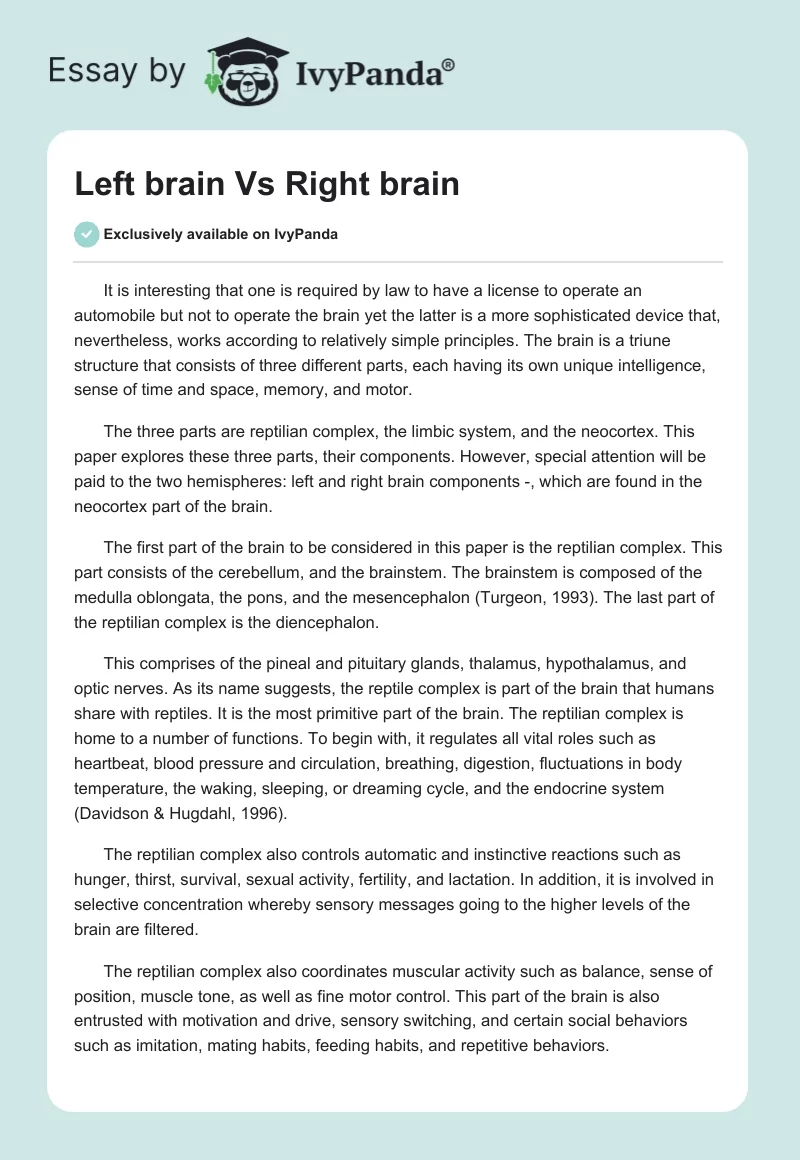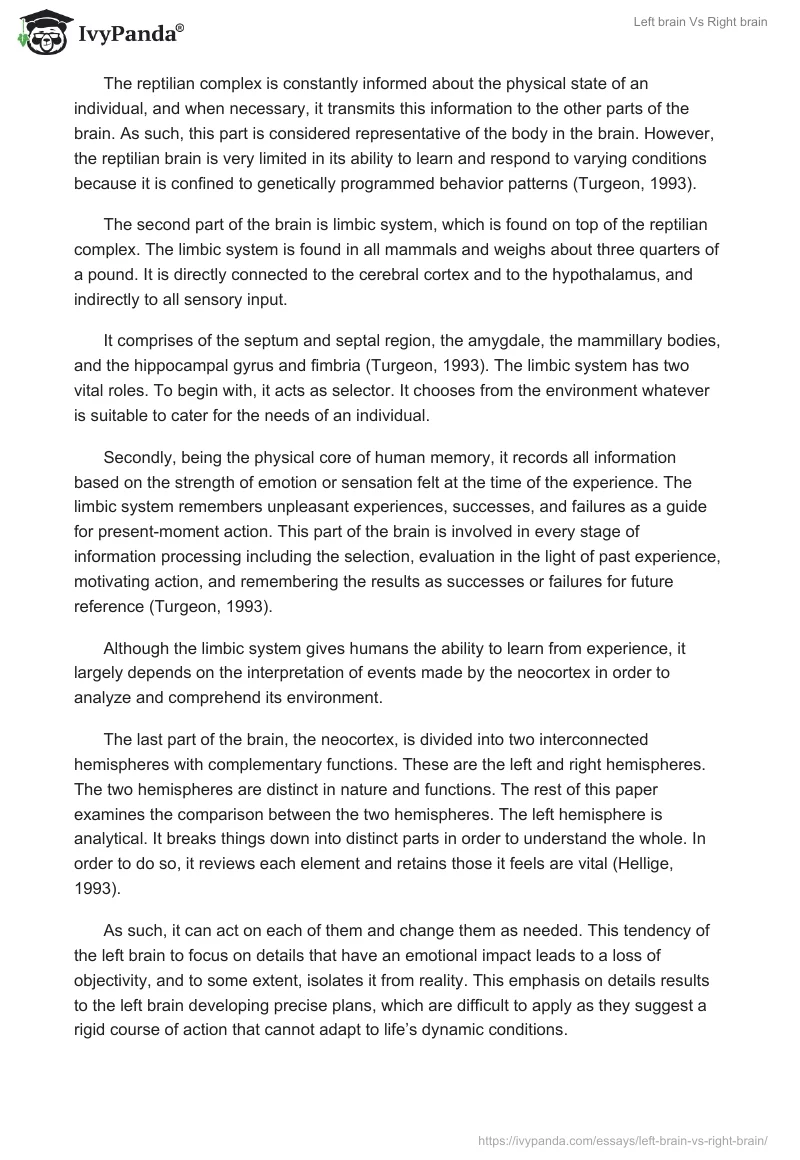It is interesting that one is required by law to have a license to operate an automobile but not to operate the brain yet the latter is a more sophisticated device that, nevertheless, works according to relatively simple principles. The brain is a triune structure that consists of three different parts, each having its own unique intelligence, sense of time and space, memory, and motor.
The three parts are reptilian complex, the limbic system, and the neocortex. This paper explores these three parts, their components. However, special attention will be paid to the two hemispheres: left and right brain components -, which are found in the neocortex part of the brain.
The first part of the brain to be considered in this paper is the reptilian complex. This part consists of the cerebellum, and the brainstem. The brainstem is composed of the medulla oblongata, the pons, and the mesencephalon (Turgeon, 1993). The last part of the reptilian complex is the diencephalon.
This comprises of the pineal and pituitary glands, thalamus, hypothalamus, and optic nerves. As its name suggests, the reptile complex is part of the brain that humans share with reptiles. It is the most primitive part of the brain. The reptilian complex is home to a number of functions. To begin with, it regulates all vital roles such as heartbeat, blood pressure and circulation, breathing, digestion, fluctuations in body temperature, the waking, sleeping, or dreaming cycle, and the endocrine system (Davidson & Hugdahl, 1996).
The reptilian complex also controls automatic and instinctive reactions such as hunger, thirst, survival, sexual activity, fertility, and lactation. In addition, it is involved in selective concentration whereby sensory messages going to the higher levels of the brain are filtered.
The reptilian complex also coordinates muscular activity such as balance, sense of position, muscle tone, as well as fine motor control. This part of the brain is also entrusted with motivation and drive, sensory switching, and certain social behaviors such as imitation, mating habits, feeding habits, and repetitive behaviors.
The reptilian complex is constantly informed about the physical state of an individual, and when necessary, it transmits this information to the other parts of the brain. As such, this part is considered representative of the body in the brain. However, the reptilian brain is very limited in its ability to learn and respond to varying conditions because it is confined to genetically programmed behavior patterns (Turgeon, 1993).
The second part of the brain is limbic system, which is found on top of the reptilian complex. The limbic system is found in all mammals and weighs about three quarters of a pound. It is directly connected to the cerebral cortex and to the hypothalamus, and indirectly to all sensory input.
It comprises of the septum and septal region, the amygdale, the mammillary bodies, and the hippocampal gyrus and fimbria (Turgeon, 1993). The limbic system has two vital roles. To begin with, it acts as selector. It chooses from the environment whatever is suitable to cater for the needs of an individual.
Secondly, being the physical core of human memory, it records all information based on the strength of emotion or sensation felt at the time of the experience. The limbic system remembers unpleasant experiences, successes, and failures as a guide for present-moment action. This part of the brain is involved in every stage of information processing including the selection, evaluation in the light of past experience, motivating action, and remembering the results as successes or failures for future reference (Turgeon, 1993).
Although the limbic system gives humans the ability to learn from experience, it largely depends on the interpretation of events made by the neocortex in order to analyze and comprehend its environment.
The last part of the brain, the neocortex, is divided into two interconnected hemispheres with complementary functions. These are the left and right hemispheres. The two hemispheres are distinct in nature and functions. The rest of this paper examines the comparison between the two hemispheres. The left hemisphere is analytical. It breaks things down into distinct parts in order to understand the whole. In order to do so, it reviews each element and retains those it feels are vital (Hellige, 1993).
As such, it can act on each of them and change them as needed. This tendency of the left brain to focus on details that have an emotional impact leads to a loss of objectivity, and to some extent, isolates it from reality. This emphasis on details results to the left brain developing precise plans, which are difficult to apply as they suggest a rigid course of action that cannot adapt to life’s dynamic conditions.
The analytical approach of the left brain presupposes a static view of life and provides the basis for the accumulation of knowledge. The left brain is the action brain. It does not seek to know the reasons driving it towards a certain goal (Iaccino, 1993). It is concerned on how to get there. As such, it proceeds by trial and error, checking out the feasibility of its theories in actual practice and experimenting until it obtains the desired results.
On the other, the right hemisphere is systematic. It grasps the whole system at once and makes sense of the parts within this overall context. This is the fundamental difference between the left and right brain. The right brain has an overview of things. It relates events to each other and studies the effects of their interaction. It is capable of acting on a group of variables concurrently in order to achieve its objective.
For instance, if the objective is long-term, it will not give up. Given that the right brain perceives an issue as a whole, it develops the broad outlines of a plan after having set very precise objectives. This plan is flexible and can be adapted to all types of situations. Nevertheless, it checks the action model against reality before applying the plan. As such, it relies on experience before heading into the unknown.
This systematic approach adopted by the right brain offers a more dynamic view of life and supports thinking. In spite of these fundamental differences, the two perceptions give rise to all the achievements of the human mind (Springer & Deutsch, 1997). This is because humans need to make full use of both sides of the brain. Nevertheless, every human being has a predisposition to one side or the other and may lack an understanding of the potentials inherent in the non-dominant side.
Under normal circumstances, the left and right hemispheres exchange information when each has hemisphere has access to the information that passed initially to the opposite hemisphere. All this occurs through the corpus callosum.
If this is the case, what happens when the corpus callosum is split? Any damage whatsoever to the corpus callosum leads to impaired exchange of information. This is evident from those who have had surgery to interrupt severe epilepsy. In these individuals, epileptic seizures are limited to only one side of the body (Servellen, 1997).
In conclusion, although the two hemispheres of the brain are different in their functions, they work together complimentarily. As discussed above, the left brain is the center for abstract thought whereby it isolates the elements of a whole and analyzes them in series.
On the abstract level, it is logical and has accurate reasoning and sound judgment. In stark contrast with this, the right brain is the center for concrete thought. It supports its thinking with actual experience and uses a collection of images taken from that experience. The practice of resourcing from the past experiences makes the right brain tend in the direction of introversion and reflection.
References
Davidson, R. J., & Hugdahl, K. (1996). Brain Asymmetry. London: MIT Press.
Hellige, J. (1993). Hemispheric asymmetry: what is right and what is left. London: Harvard University Press.
Iaccino, J. F. (1993). Left brain–right brain differences: inquiries, evidence and new approaches. Pennsylvania: Lawrence Erlbaum Associates.
Servellen, G. M. (1997). Communication skills for the health care professional: concepts and techniques. London: Jones & Bartlett Learning.
Springer, S. P., & Deutsch, G. (1997). Left brain, right brain: perspectives on cognitive neuroscience. London: Freeman.
Turgeon, M. (1993). Right-brain left-brain reflexology: a self-help approach to balancing life energies with color, sound, and pressure point techniques. New York: Traditions Bear & Co.


